Interferometric DEM-Assisted High Precision Imaging Method for ArcSAR
Abstract
1. Introduction
2. The Geometric Model and Signal Model of ArcSAR
3. Analyzing the Error Caused by ArcSAR Imaging on the Reference Plane
3.1. The Error Model of ArcSAR Imaging on the Reference Plane
3.2. The Relationship between Height Difference Threshold and System Parameters
4. The Principle of Interferometric DEM-Assisted High Precision Imaging Method for ArcSAR
4.1. Interferometric ArcSAR Extraction DEM of Scenes
4.2. DEM Image Transforming from Slant Range to Ground Range
- When θ = θi (i = 1, 2, ..., N), the sequence DEMs are taken from the DEM image. This sequence stores the DEM data in the DEM image at θ = θi. Its size is M×1. At the same time, we define a slant range sequence Rn. It stores the slant range corresponding to each element in the sequence DEMs, which can be expressed as:
- We calculate the ground range sequence Rg using the geometric relationship between the sequence DEMs and the sequence Rn. The flow chart of the calculation process is shown in Figure 9. Sequence Rg stores the ground range corresponding to each DEM data in the sequence DEMs.
- We define a ground range sequence Rge, which is an increasing sequence. Its size is M × 1. Furthermore, the largest element of this sequence is Rge(M), which is equal to the Rg(M). The difference of adjacent elements in Rge is fixed.
- We acquire the element in the sequence Rg that is numerically closest to the element Rge (j), which we define as Rne.
- According to the position of Rne in the sequence Rg, the DEM data corresponding to the element Rne in the sequence DEMs can be found. We named these DEM data as Hne.
- Since Rge(j) is numerically close to Rne, the position of their corresponding DEM data on the DEM image will be very close. Therefore, we assume that the DEM data of Rge(j) are also Hne.
- According to Rge(j) and Hne, the slant range corresponding to Rge(j) can be calculated:
- Let Rnew interpolate on the sequence Rn (the purpose of this operation is to find the position of Rnew on the sequence Rn). According to the position of Rnew on the sequence Rn, we can find the DEM data corresponding to Rnew on the sequence DEMs, which we define as Hnew.
- Since Rge(j) is the ground range corresponding to Rnew, the DEM data of Rge(j) are also Hnew.
5. Accuracy Analysis
5.1. The DEM Accuracy Analysis
5.1.1. Phase Error Analysis as the Decrease of the SNR Caused by Image Defocusing
5.1.2. Phase Error due to the Difference in Phase Distortion of the SAR Images
5.1.3. The Effects of Phase Errors on DEM Accuracy
5.2. Deformation Monitoring Accuracy Analysis
6. Experiment
6.1. The Simulation Experiment of Interferometric ArcSAR Extraction DEM
6.2. Distributed Scenes Imaging Simulation Experiment Verification the DEM-Assisted High Precision Imaging Method for ArcSAR
7. Conclusions
Author Contributions
Funding
Conflicts of Interest
References
- Guaragnella, C.; D’Orazio, T. A Data-Driven Approach to SAR Data-Focusing. Sensors 2019, 19, 1649. [Google Scholar] [CrossRef] [PubMed]
- Xin, L.; Tingting, L.; Kaizhi, W.; Xingzhao, L. A novel concept of plane grid resolution for high-resolution SAR imaging systems. In Proceedings of the 2014 IEEE Geoscience and Remote Sensing Symposium, Quebec City, QC, Canada, 13–18 July 2014; pp. 358–361. [Google Scholar]
- Colesanti, C.; Locatelli, R.; Novali, F. Ground Deformation Monitoring Exploiting SAR Permanent Scatterers. In Proceedings of the IEEE International Geoscience and Remote Sensing Symposium, Toronto, ON, Canada, 24–28 June 2002; pp. 1219–1221. [Google Scholar]
- Xie, P.; Zhang, M.; Zhang, L.; Wang, G. Residual Motion Error Correction with Backprojection Multisquint Algorithm for Airborne Synthetic Aperture Radar Interferometry. Sensors 2019, 19, 2342. [Google Scholar] [CrossRef] [PubMed]
- Cao, N.; Lee, H.; Zaugg, E.; Shrestha, R.; Carter, W.E.; Glennie, C.; Lu, Z.; Yu, H. Estimation of Residual Motion Errors in Airborne SAR Interferometry Based on Time-Domain Backprojection and Multisquint Techniques. IEEE Trans. Geosci. Remote. Sens. 2018, 56, 2397–2407. [Google Scholar] [CrossRef]
- Ruiz-Armenteros, A.M.; Manuel Delgado, J.; Ballesteros-Navarro, B.J.; Lazecky, M.; Bakon, M.; Sousa, J.J. Deformation monitoring of the northern sector of the Valencia Basin (E Spain) using Ps-InSAR (1993–2010). In Proceedings of the IGARSS 2018-2018 IEEE International Geoscience and Remote Sensing Symposium, Valencia, Spain, 23–27 July 2018; pp. 2244–2247. [Google Scholar]
- Qi, Y.; Wang, Y.; Yang, X.; Li, H. Application of Microwave Imaging in Regional Deformation Monitoring using Ground Based SAR. In Proceedings of the Asian-Pacific Conference on Synthetic Aperture Radar (APSAR 2015), Singapore, 1–4 September 2015. [Google Scholar]
- Pieraccini, M.; Miccinesi, L.; Rojhani, N. A GBSAR Operating in Monostatic and Bistatic Modalities for Retrieving the Displacement Vector. IEEE Geosci. Remote. Sens. Lett. 2017, 14, 1–5. [Google Scholar] [CrossRef]
- Chan, Y.K.; Chu, C.Y. Ground based synthetic aperture radar for land deformation monitoring: Preliminary result. In Proceedings of the 2016 Progress in Electromagnetic Research Symposium (PIERS), Shanghai, China, 8–11 August 2016; pp. 2540–2542. [Google Scholar]
- Liu, Y.; Lee, C.; Yong, H.; Jia, L.; Youshi, W.; Placidi, S.; Roedelsperger, S. FastGBSAR case studies in China: Monitoring of a dam and instable slope. In Proceedings of the 2015 IEEE 5th Asia-Pacific Conference on Synthetic Aperture Radar (APSAR), Marina Bay Sands, Singapore, 1–4 September 2015; pp. 849–852. [Google Scholar]
- Yang, X.; Wang, Y.; Qi, Y.; Tan, W.; Hong, W. Experiment Study on Deformation Monitoring Using Ground-Based SAR. In Proceedings of the Asian-Pacific Conference on Synthetic Aperture Radar (APSAR 2013), Tsukuba, Japan, 23–27 September 2013. [Google Scholar]
- Garmatyuk, D.; Narayanan, R. Ultra-wideband continuous-wave random noise arc-SAR. IEEE Trans. Geosci. Remote. Sens. 2002, 40, 2543–2552. [Google Scholar] [CrossRef]
- Zhang, J. The static small object detection based on ground-based arc SAR. In Proceedings of the 2012 International Conference on Microwave and Millimeter Wave Technology (ICMMT), Shenzhen, China, 5–8 May 2012. [Google Scholar]
- Huang, Z.; Tan, W.; Huang, P.; Sun, J.; Qi, Y.; Wang, Y. Imaging algorithm study on ARC antenna array ground-based SAR. In Proceedings of the 2017 IEEE International Geoscience and Remote Sensing Symposium (IGARSS), Fort Worth, TX, USA, 23–28 July 2017; pp. 1634–1637. [Google Scholar]
- Rodriguez, A.C.F.; Fraidenraich, G.; Soares, T.A.P.; Filho, J.C.S.S.; Miranda, M.A.M.; Yacoub, M.D. Optimal and Suboptimal Velocity Estimators for ArcSAR with Distributed Target. IEEE Geosci. Remote. Sens. Lett. 2018, 15, 252–256. [Google Scholar] [CrossRef]
- Viviani, F.; Michelini, A.; Mayer, L.; Conni, F. IBIS-ArcSAR: an Innovative Ground-Based SAR System for Slope Monitoring. In Proceedings of the IGARSS 2018 IEEE International Geoscience and Remote Sensing Symposium, Valencia, Spain, 23–27 July 2018; pp. 1348–1351. [Google Scholar]
- Luo, Y.; Song, H.; Wang, R.; Xu, Z.; Li, Y. Signal processing of Arc FMCW SAR. Proceedings of 2013 Asia-Pacific Conference on Synthetic Aperture Radar (APSAR), Tsukuba, Japan, 23–27 September 2013. [Google Scholar]
- Luo, Y.; Song, H.; Wang, R.; Deng, Y.; Zhao, F.; Xu, Z. Arc FMCW SAR and Applications in Ground Monitoring. IEEE Trans. Geosci. Remote. Sens. 2014, 52, 5989–5998. [Google Scholar] [CrossRef]
- Lee, H.; Cho, S.-J.; Kim, K.-E. A ground-based Arc-scanning synthetic aperture radar (ArcSAR) system and focusing algorithms. In Proceedings of the 2010 IEEE International Geoscience and Remote Sensing Symposium, Honolulu, HI, USA, 25–30 July 2010; pp. 3490–3493. [Google Scholar]
- Lee, H.; Lee, J.-H.; Kim, K.-E.; Sung, N.-H.; Cho, S.-J. Development of a Truck-Mounted Arc-Scanning Synthetic Aperture Radar. IEEE Trans. Geosci. Remote Sens. 2014, 52, 2773–2779. [Google Scholar] [CrossRef]
- Cumming, I.G.; Wong, F.H. Digital processing of synthetic aperture radar data: Algorithms and implementation. ARTECH HOUSE: Norwood, MA, USA, 2004; ISBN 978-1-580-53058-3. [Google Scholar]
- Pieraccini, M.; Miccinesi, L. ArcSAR for detecting target elevation. Electron. Lett. 2016, 52, 1559–1561. [Google Scholar] [CrossRef]
- Pieraccini, M.; Miccinesi, L. ArcSAR: Theory, Simulations, and Experimental Verification. IEEE Trans. Microw. Theory Tech. 2017, 65, 293–301. [Google Scholar] [CrossRef]
- Zebker, H.; Werner, C.; Rosen, P.; Hensley, S. Accuracy of topographic maps derived from ERS-1 interferometric radar. IEEE Trans. Geosci. Remote. Sens. 1994, 32, 823–836. [Google Scholar] [CrossRef]
- Li, F.; Han, B.; Lin, X.; Hu, D.; Ding, C. A method of airborne InSAR DEM reconstruction in layover areas. In Proceedings of the 2012 IEEE International Geoscience and Remote Sensing Symposium, Munich, Germany, 22–27 July 2012. [Google Scholar]
- Nico, G.; Leva, D.; Antonello, G.; Tarchi, D. Ground-based SAR interferometry for terrain mapping: Theory and sensitivity analysis. IEEE Trans. Geosci. Remote. Sens. 2004, 42, 1344–1350. [Google Scholar] [CrossRef]
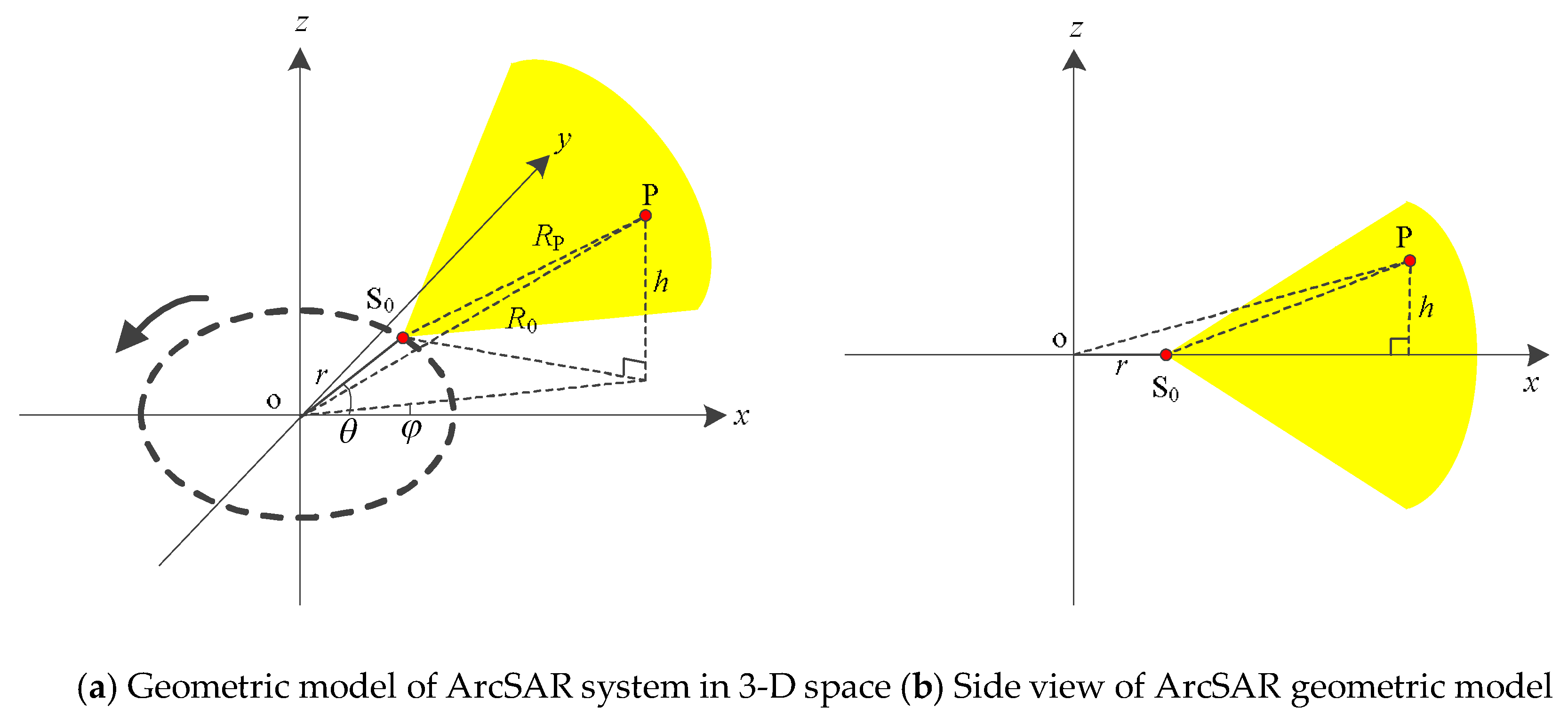
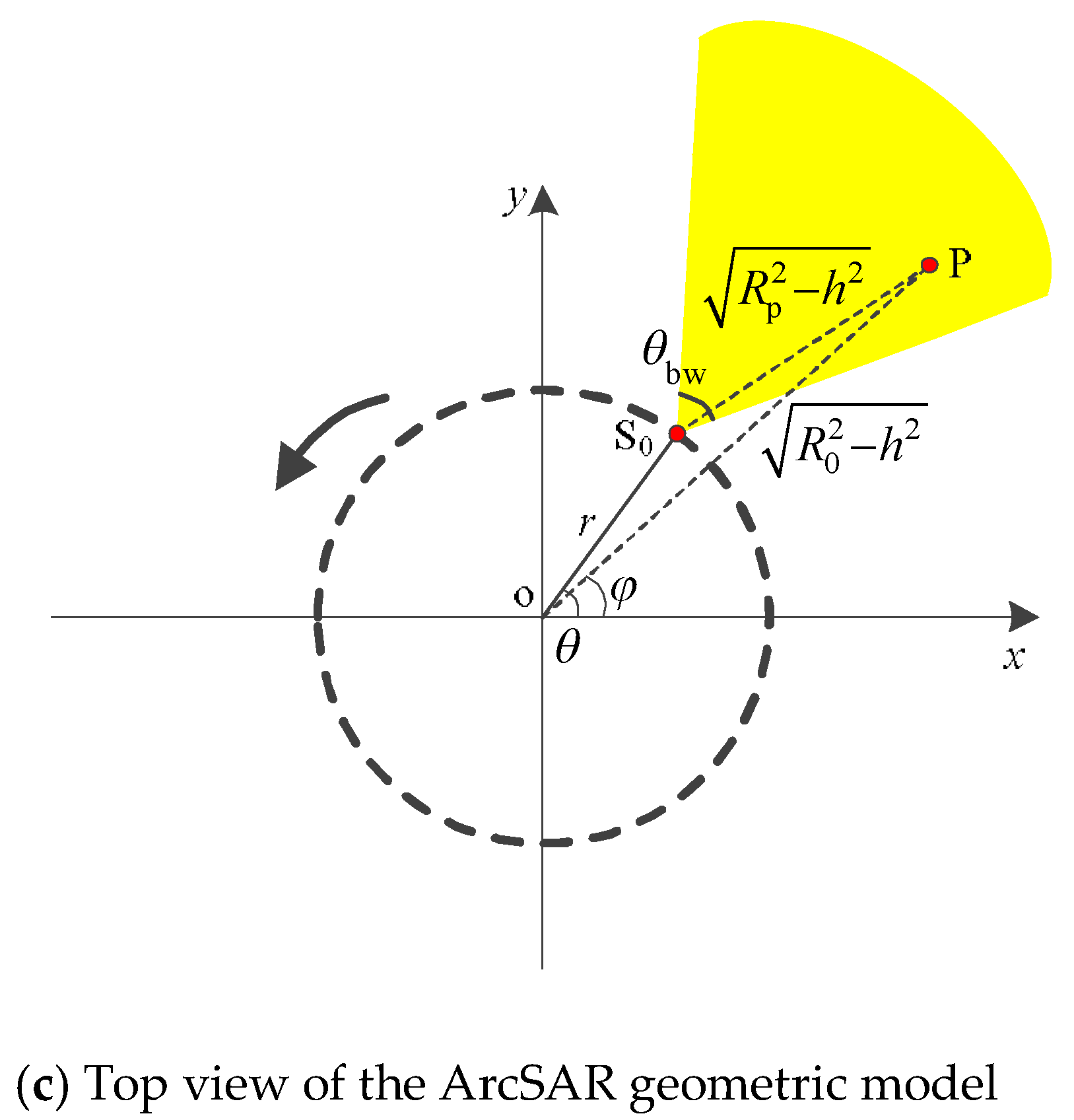
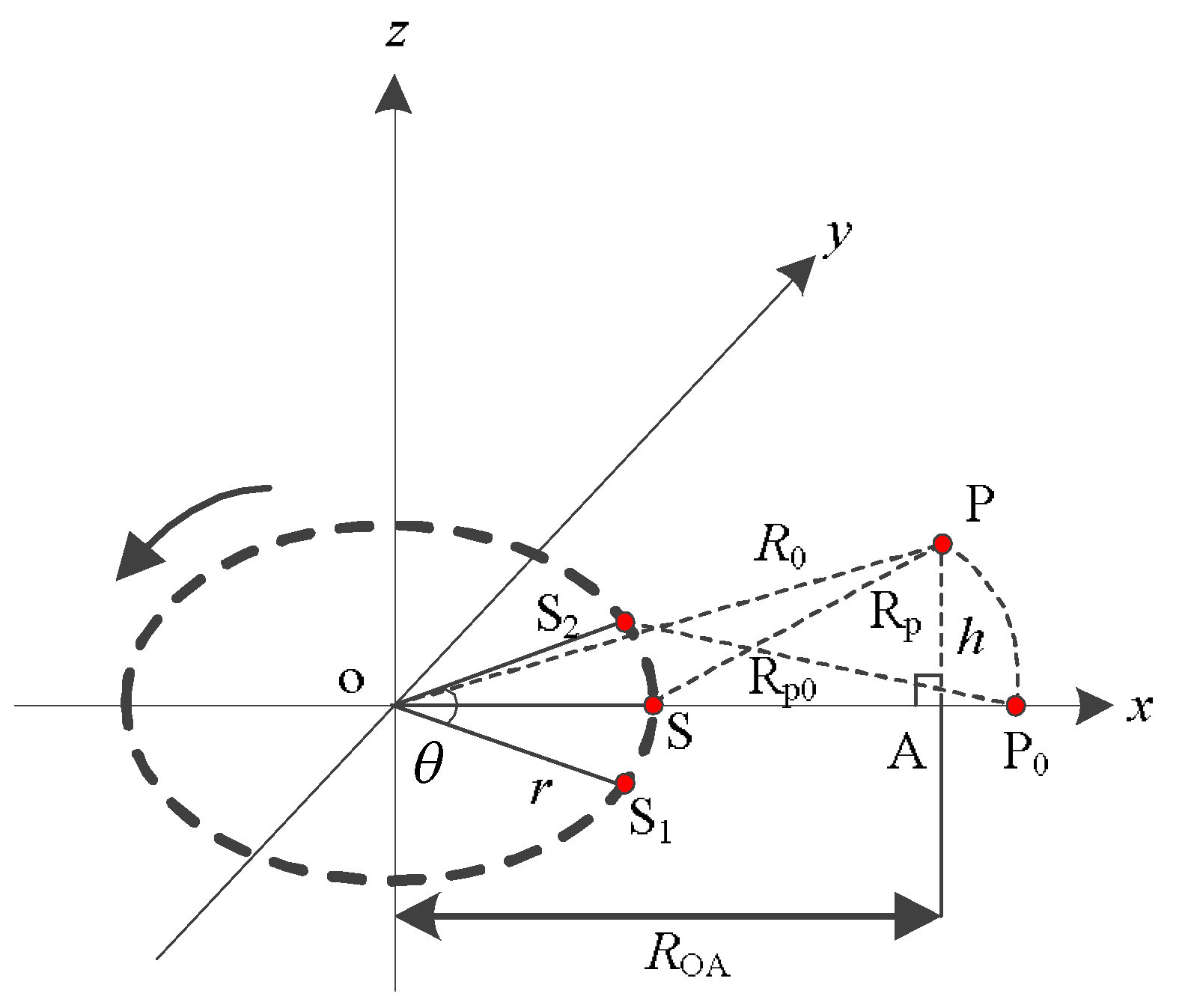
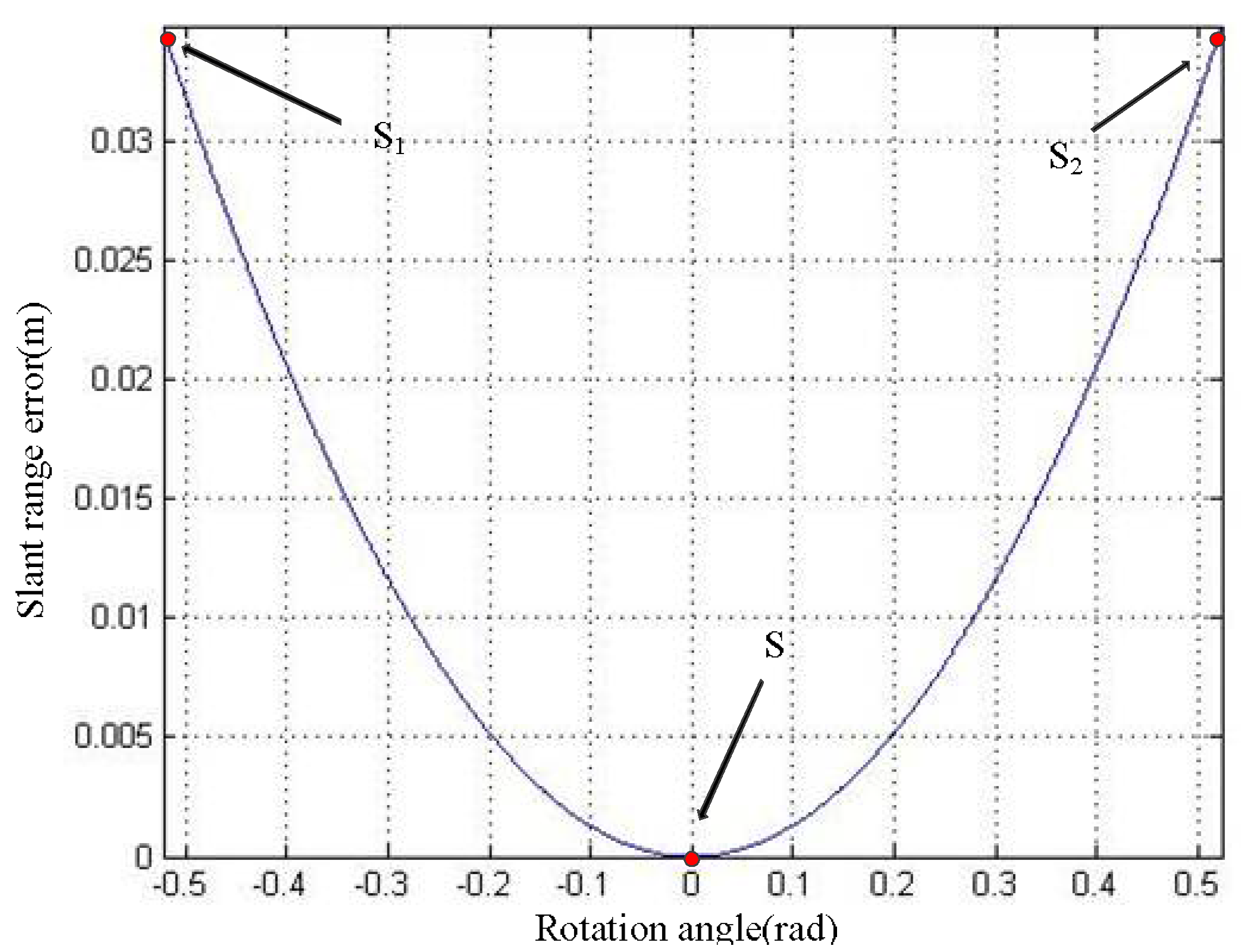


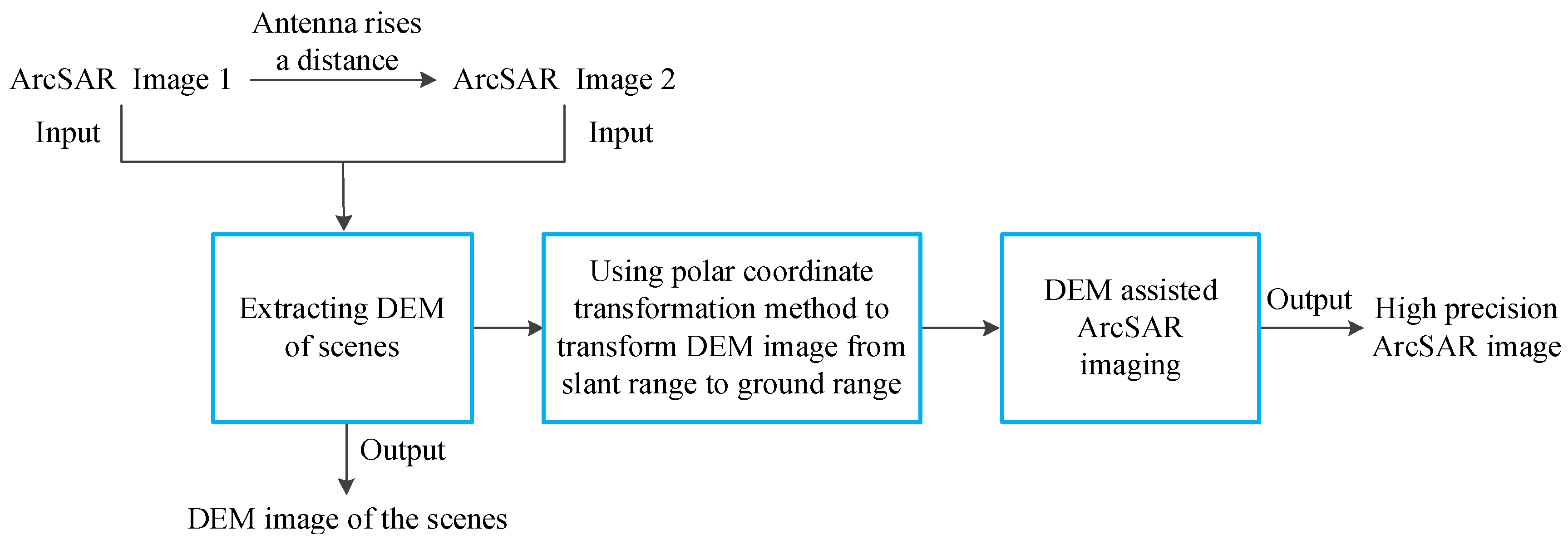
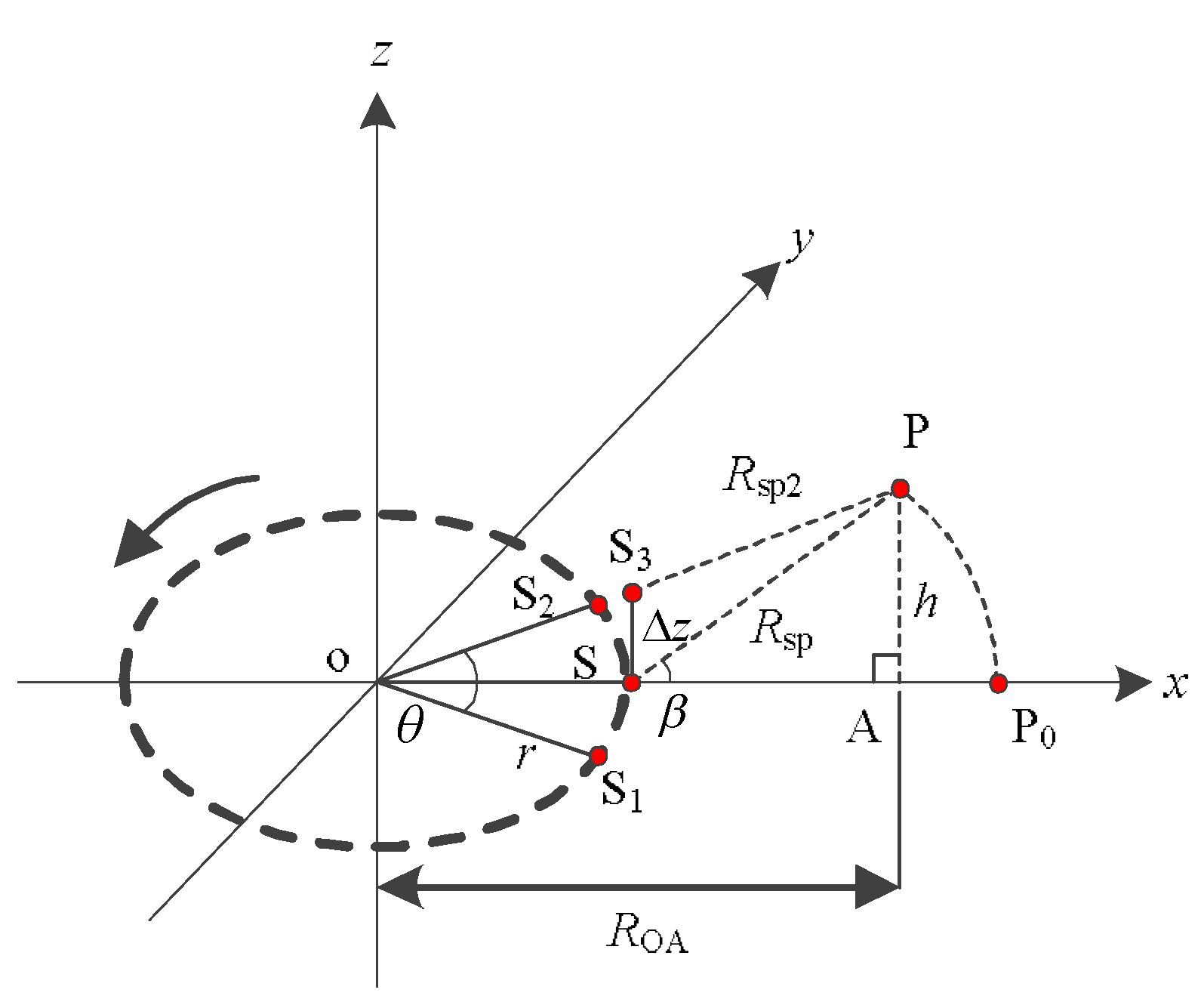
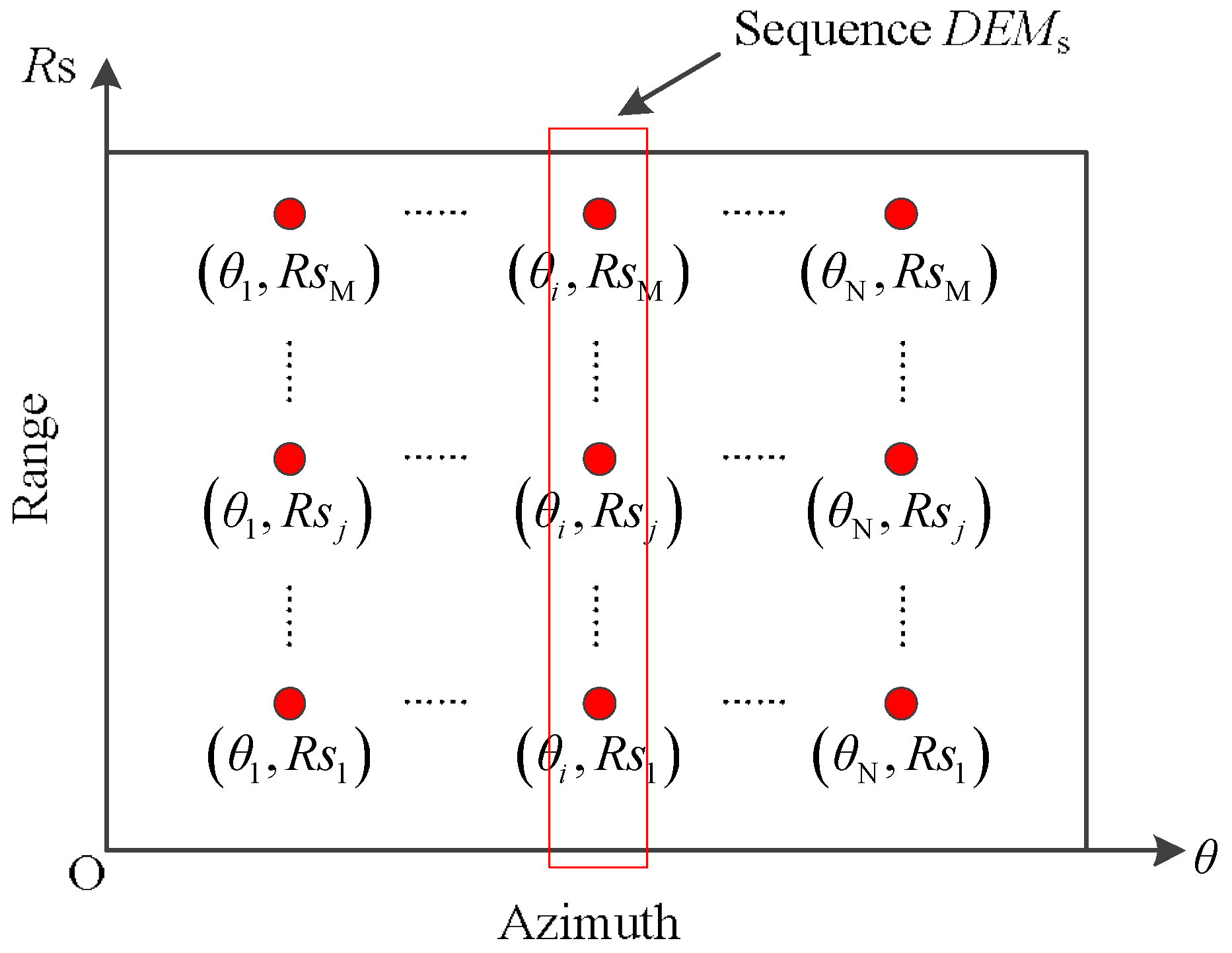

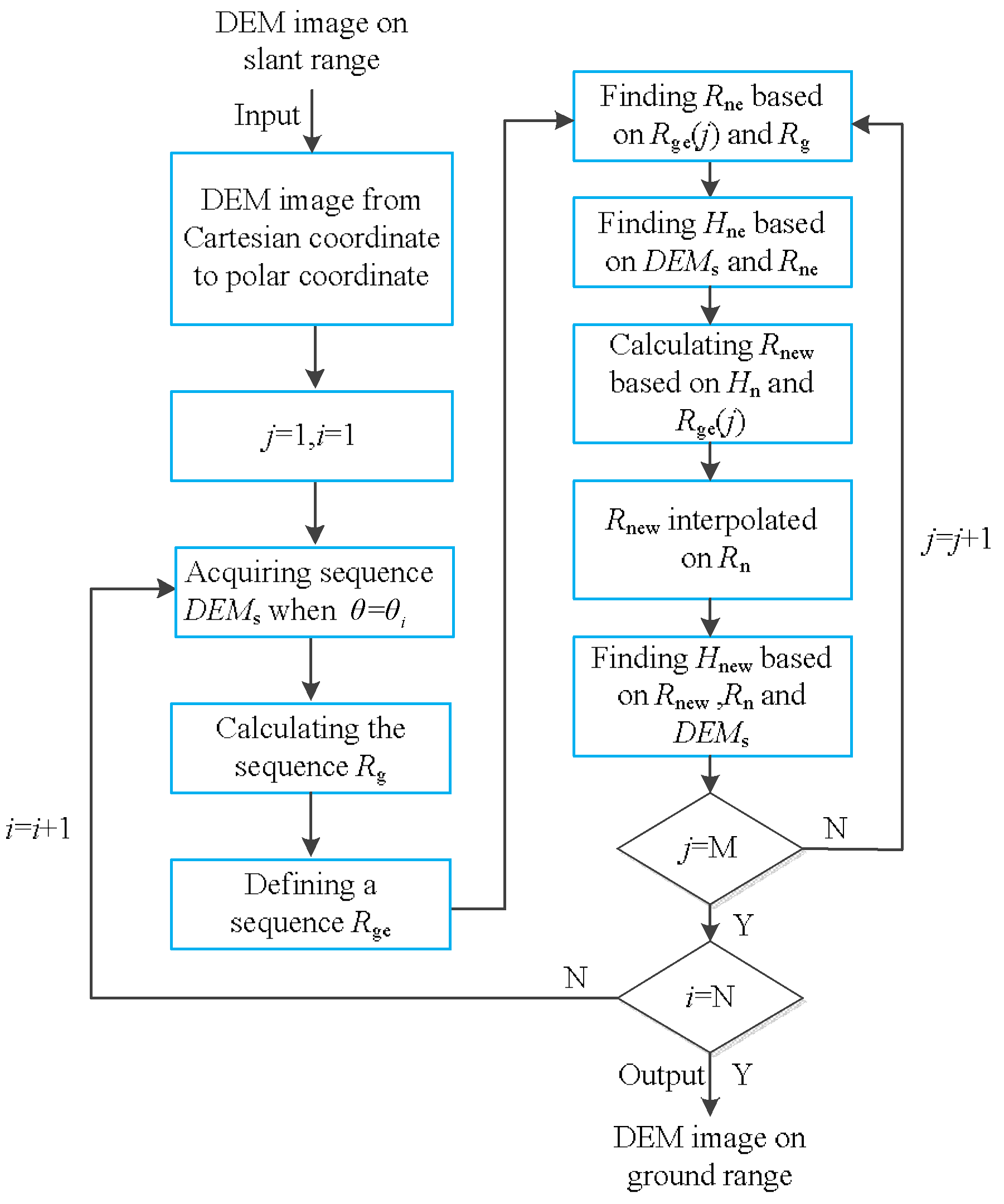
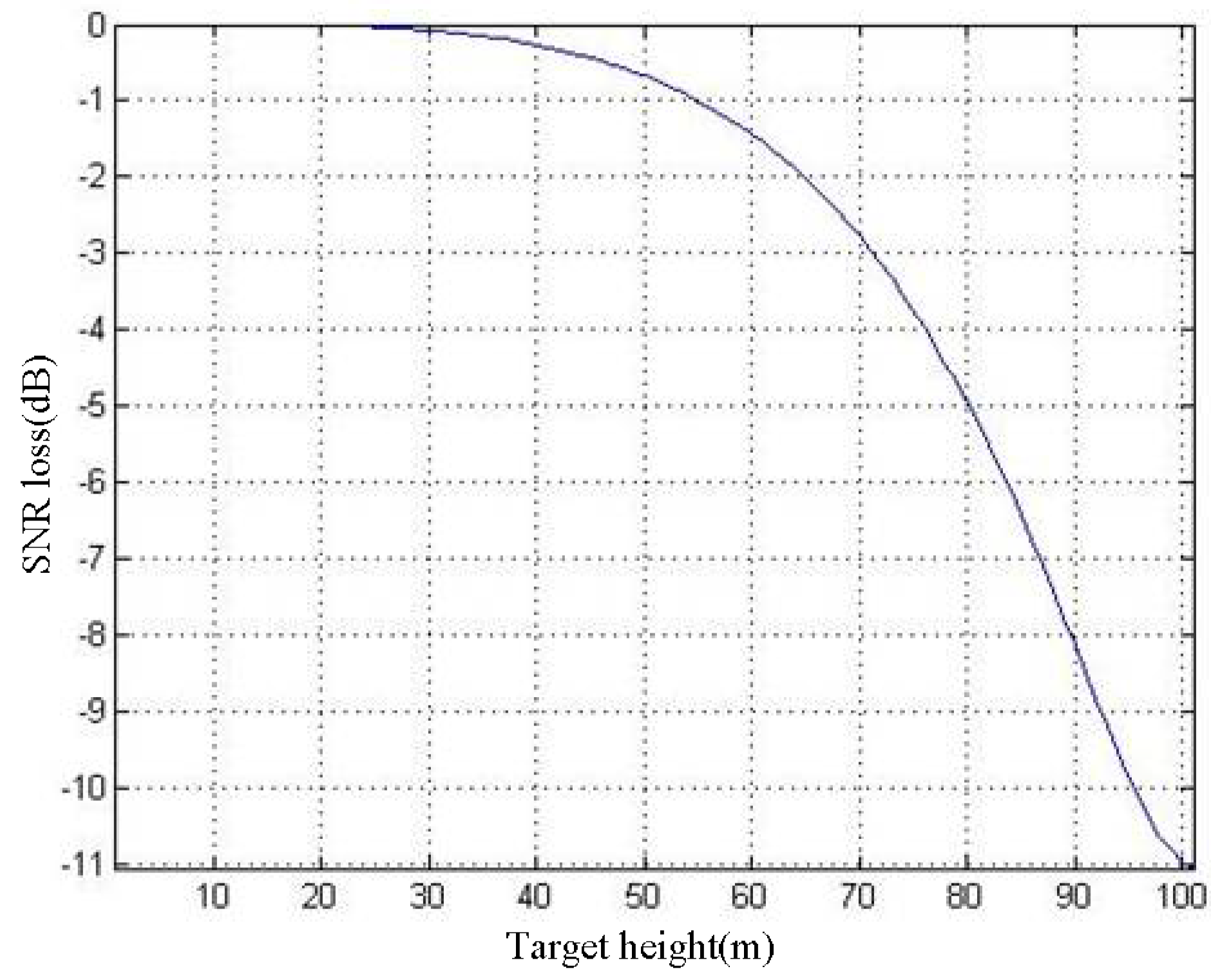
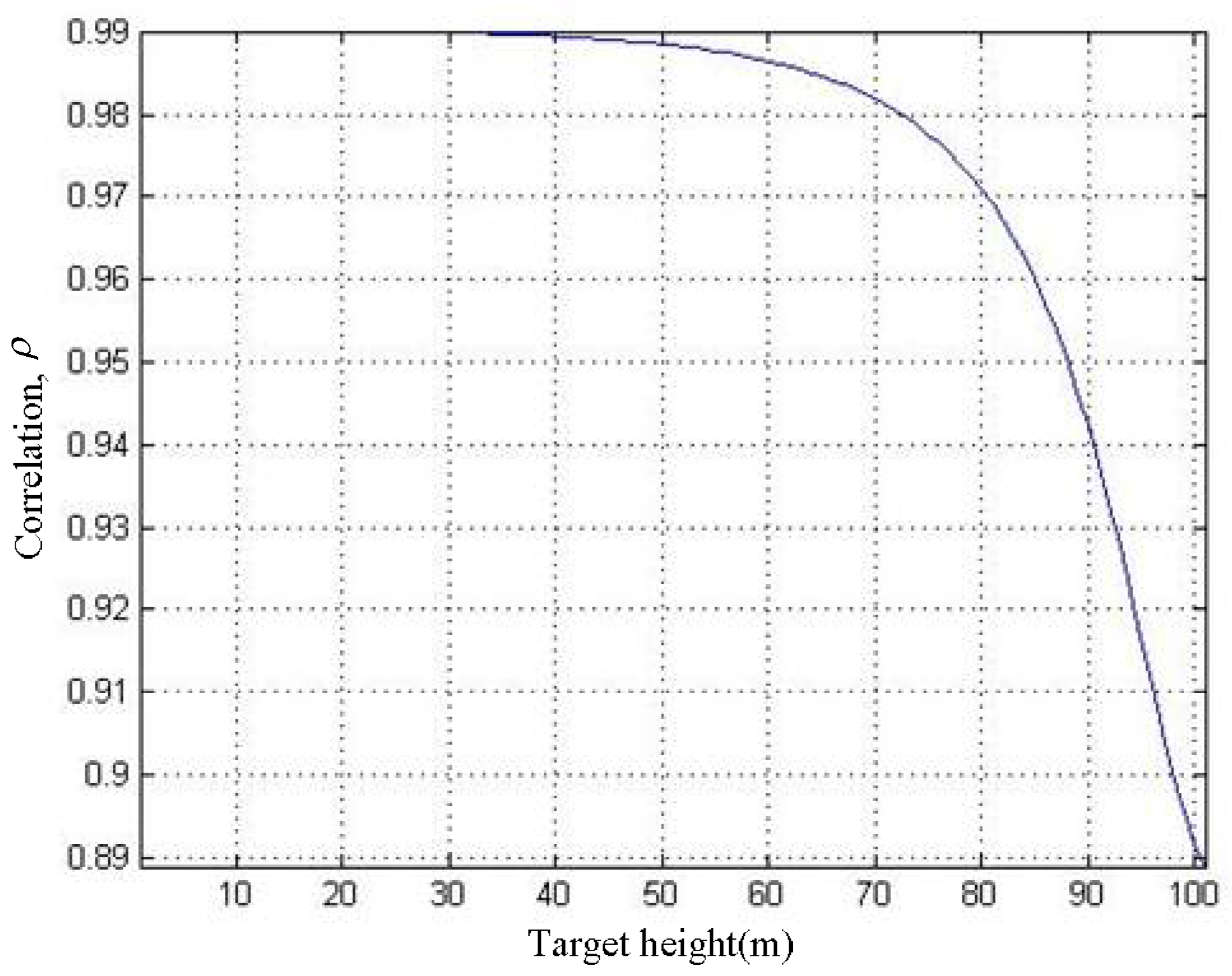
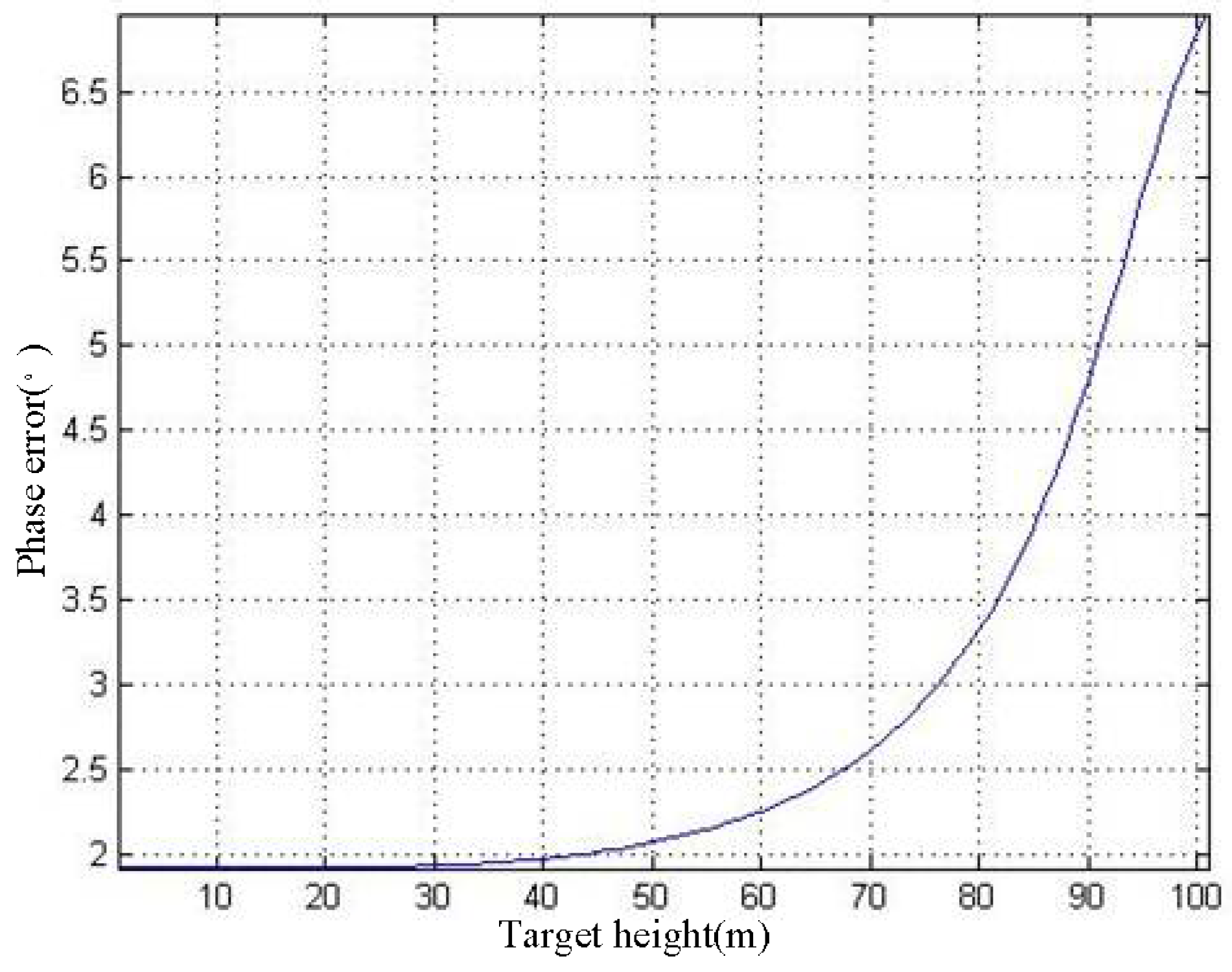
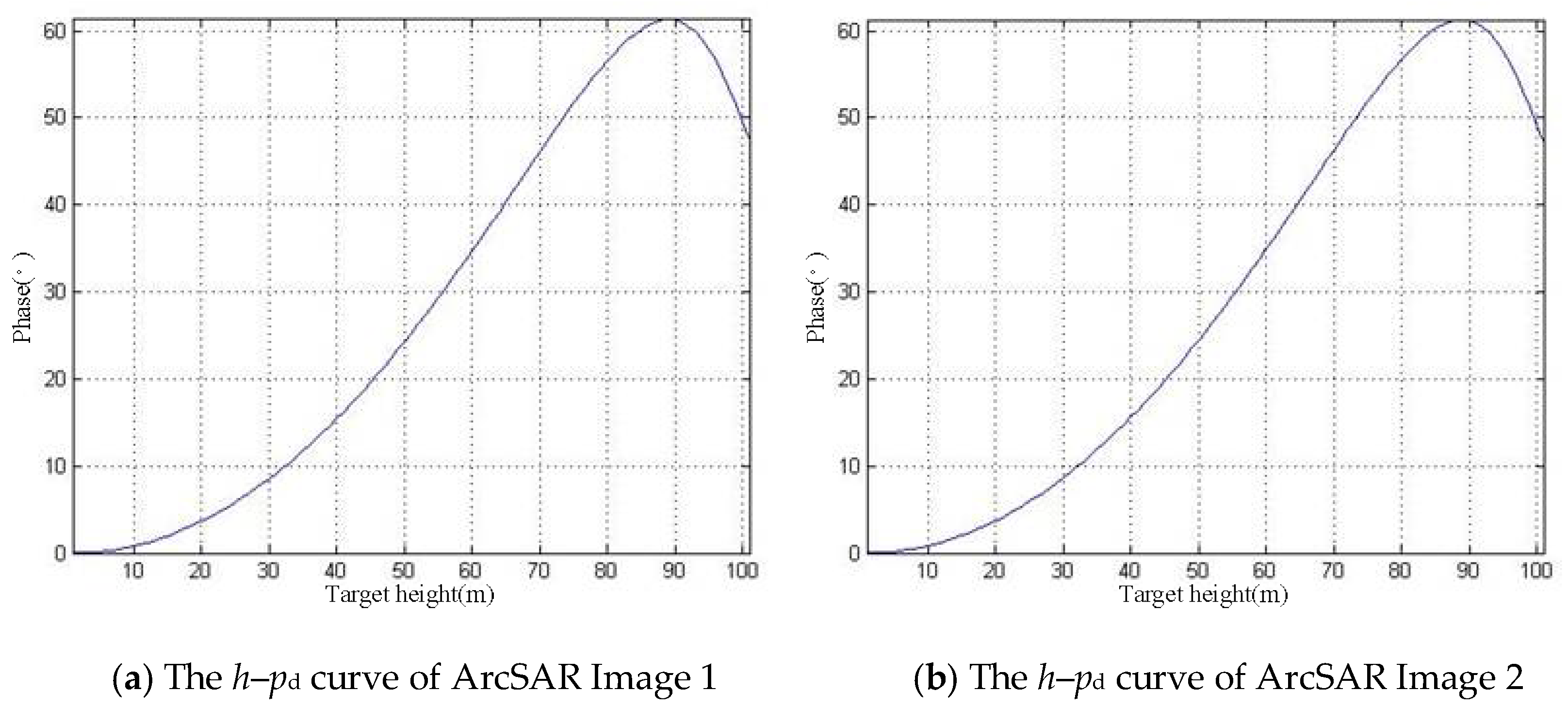
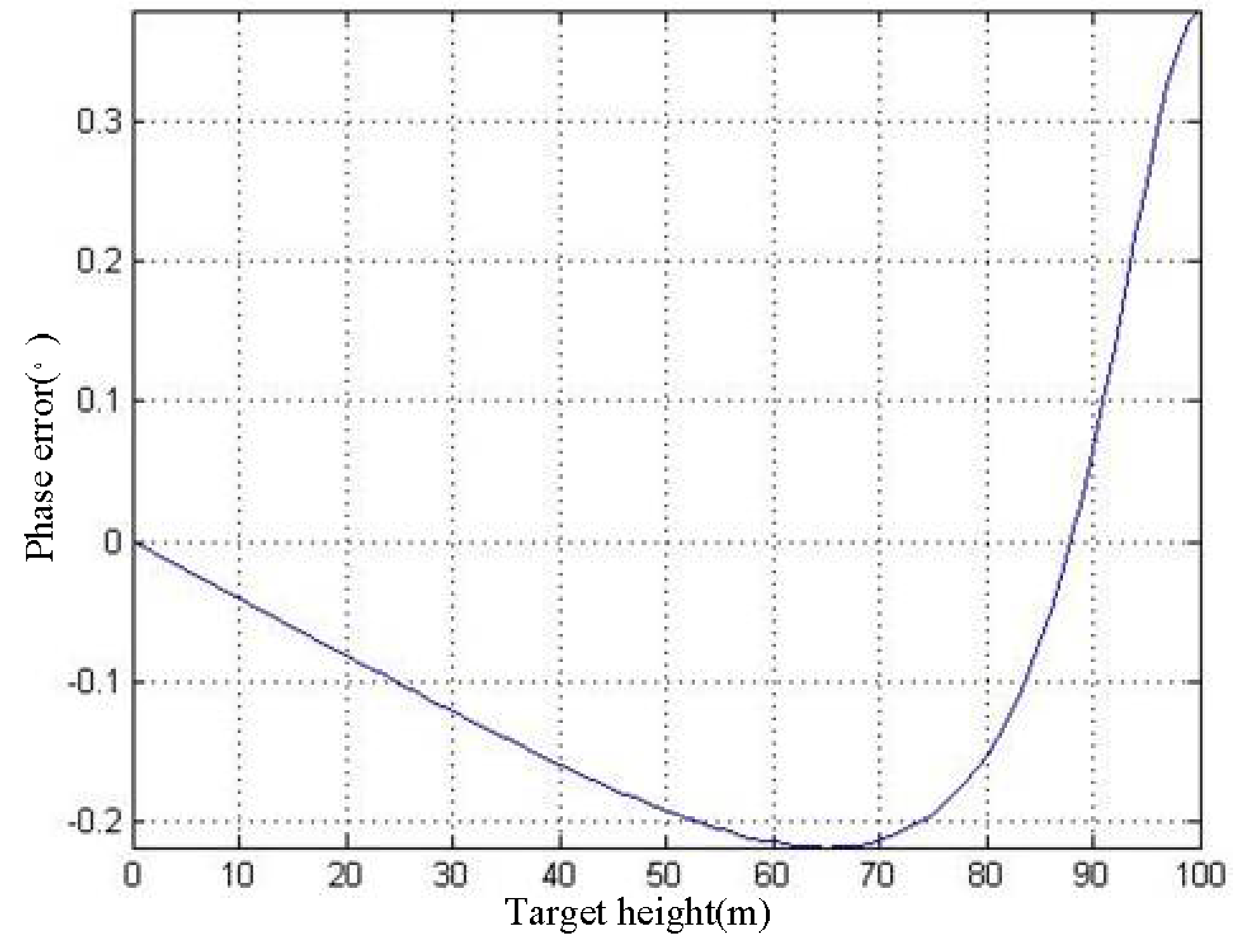
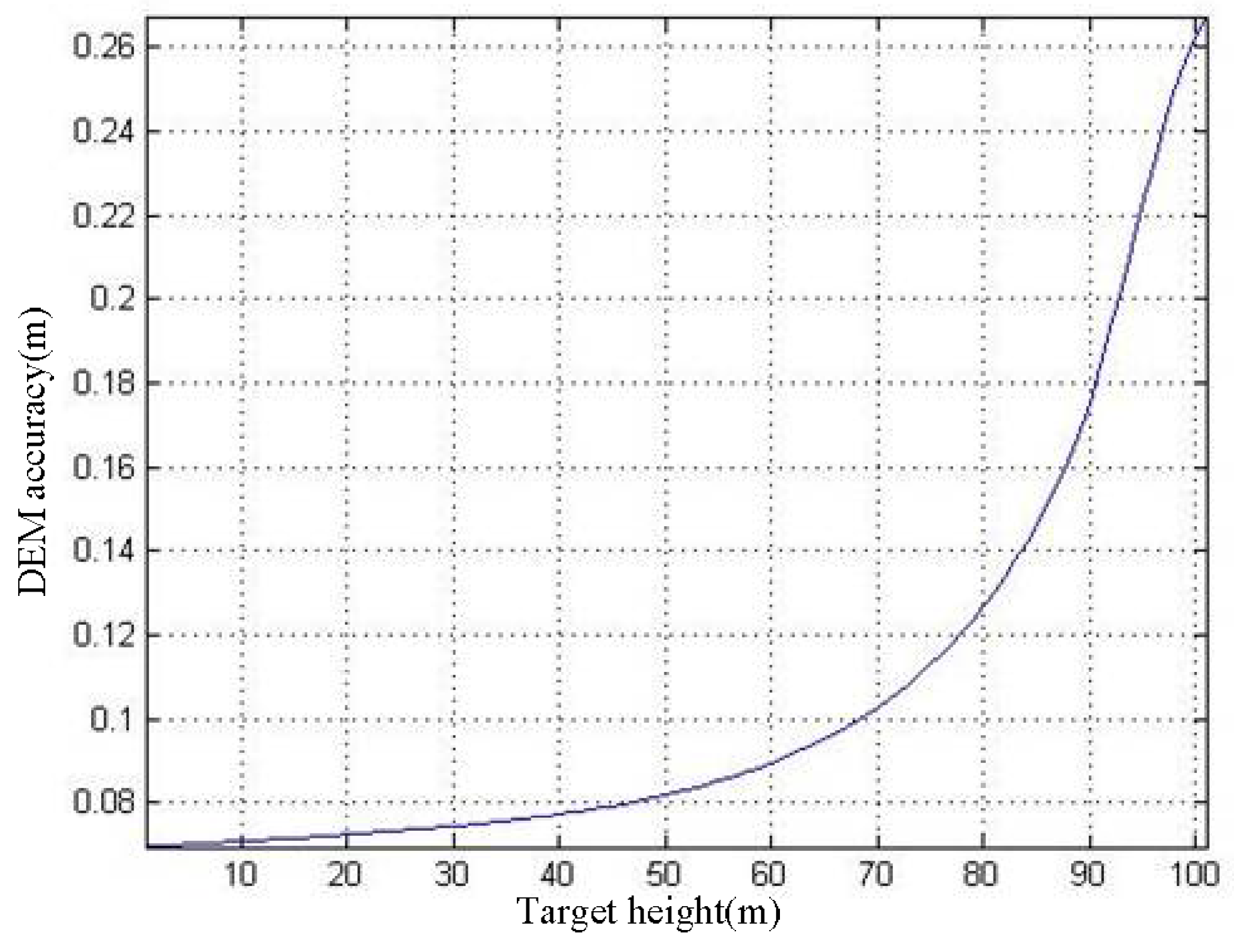
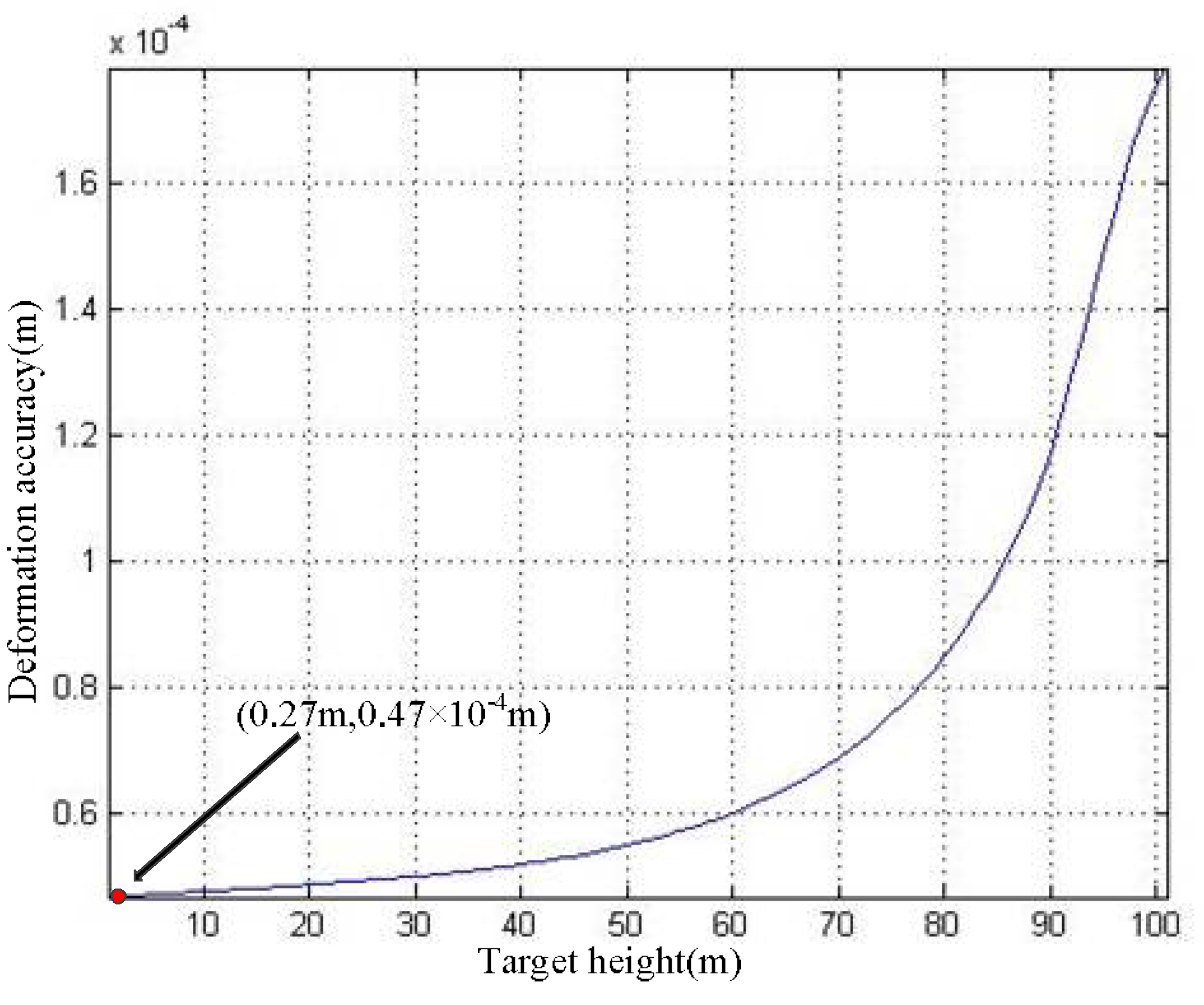
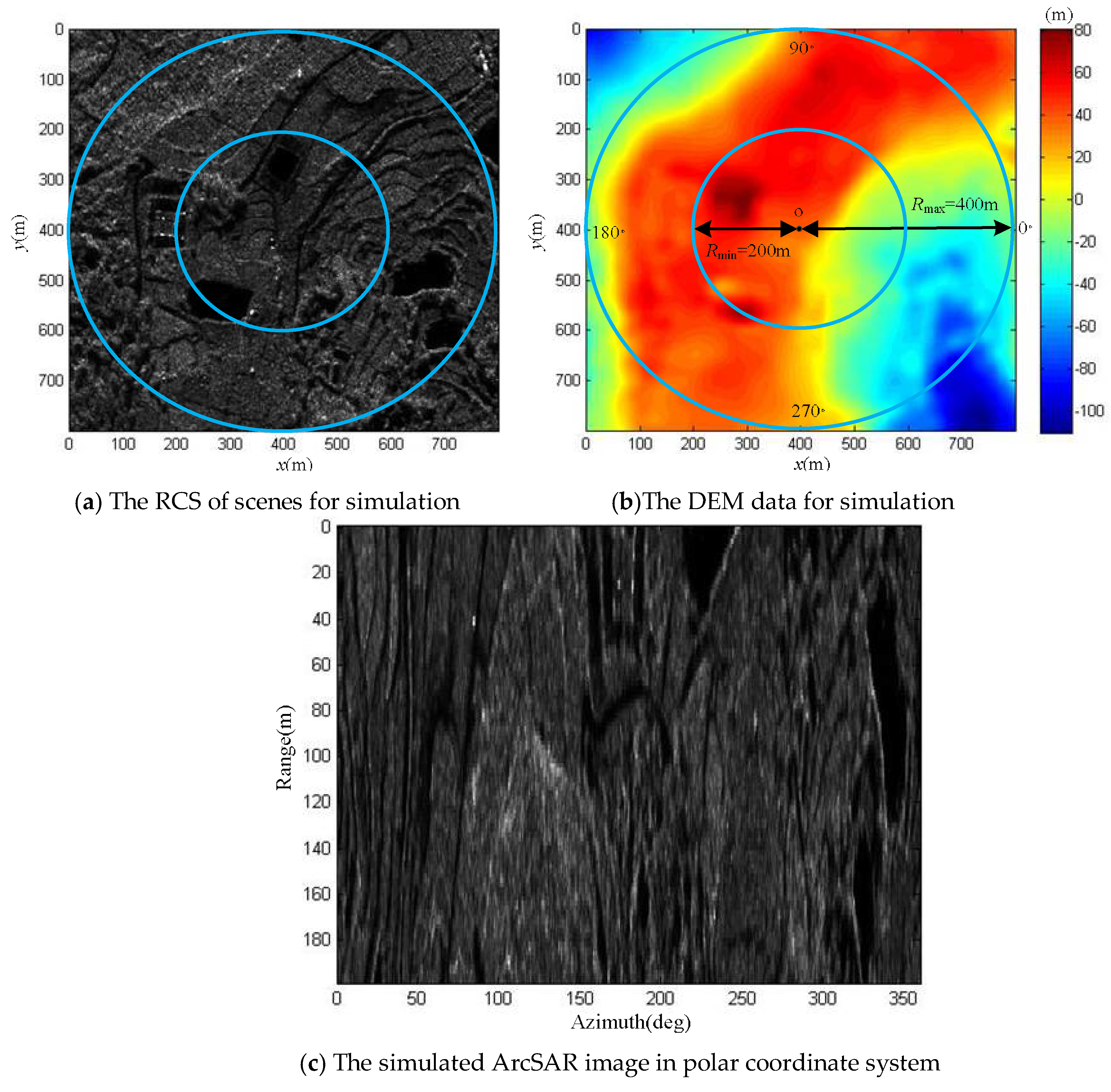



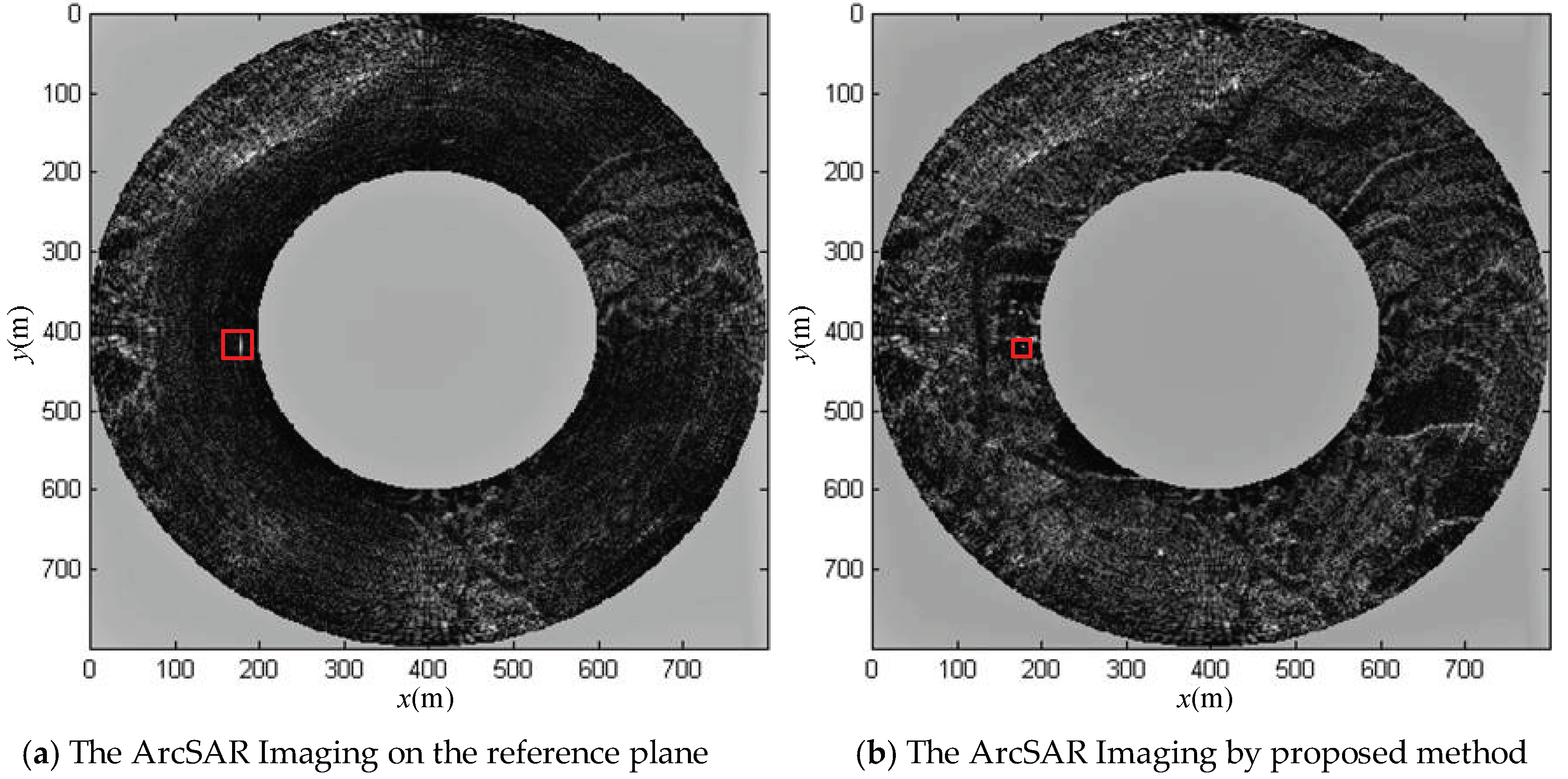
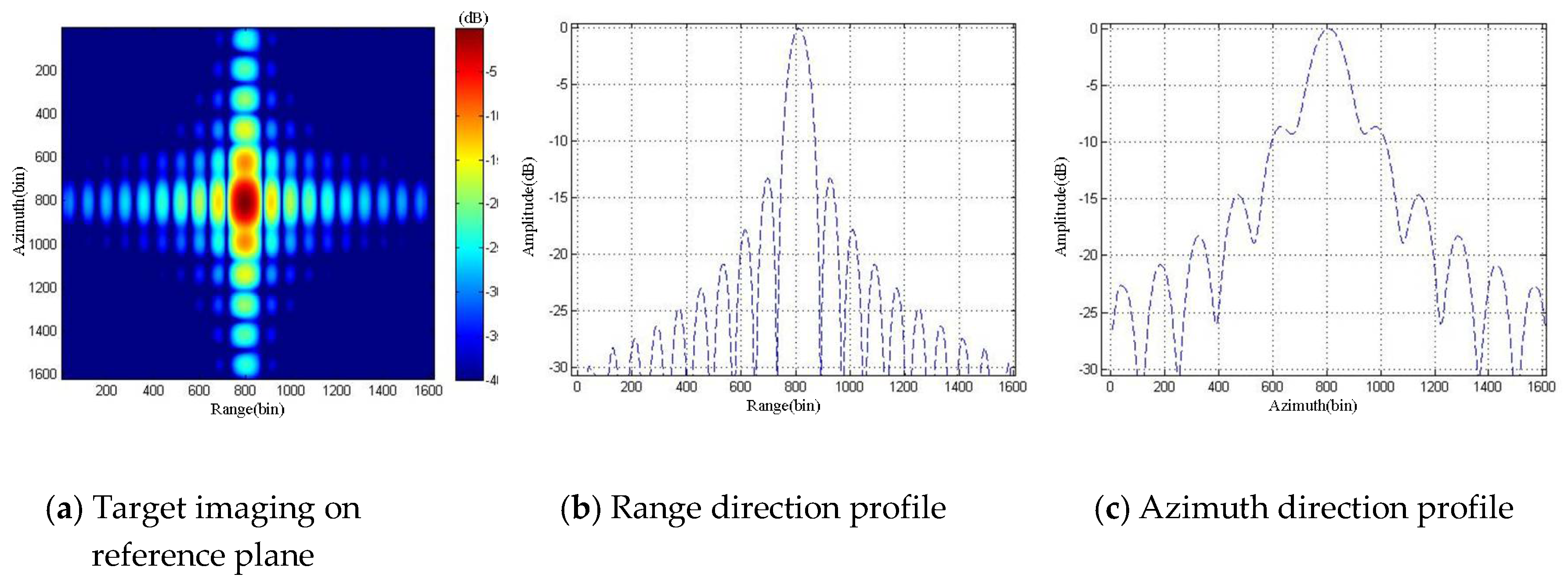
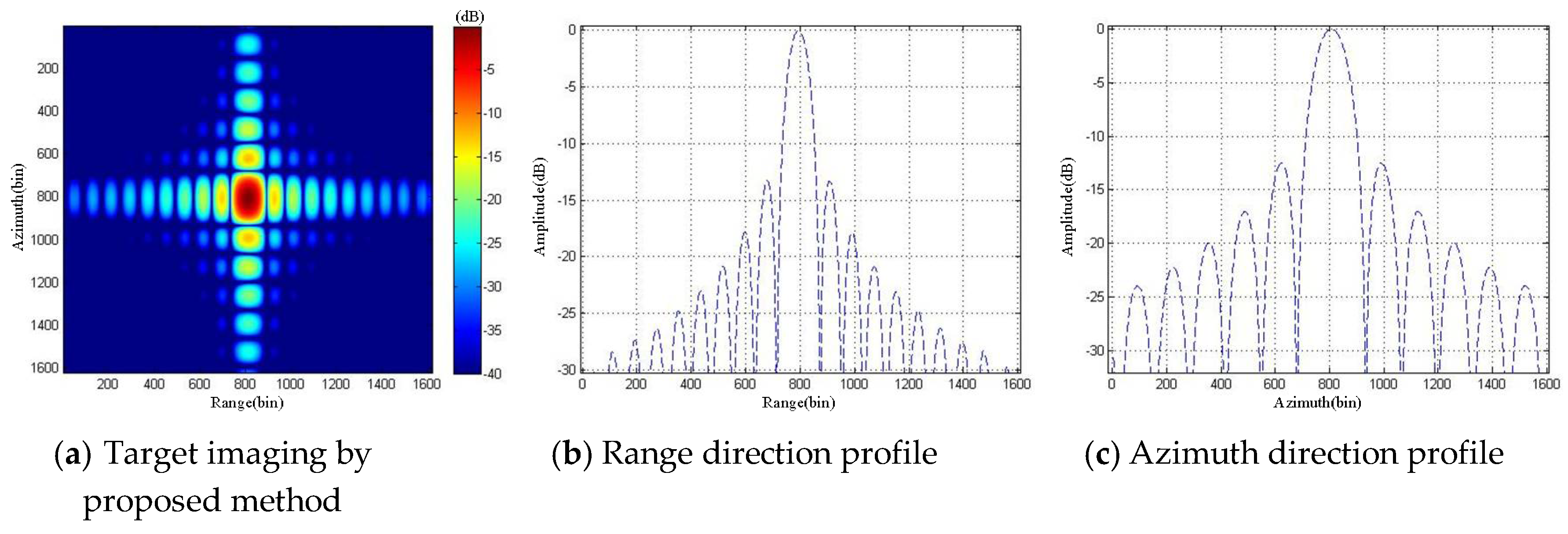
| r (m) | θbw (rad) | θ (rad) | λ (mm) | Rsp (m) | Br (MHz) |
|---|---|---|---|---|---|
| 1 | π/3 | π/3 | 17.50 | 300 | 150 |
| r (m) | θbw (rad) | θ (rad) | λ (mm) | Br (MHz) | Rmax (m) | Rmin (m) |
|---|---|---|---|---|---|---|
| 1 | π/3 | 2π | 17.50 | 150 | 400 | 200 |
| Parameters | Imaging on Reference Plane | Imaging by Proposed Method |
|---|---|---|
| Coordinates (m,deg) | (220.91,185.19) | (220.91,185.19) |
| Height (m) | 36.82 | 36.82 |
| Range direction resolution (m) | 1.00 | 1.00 |
| Range direction PSLR (dB) | −13.21 | −13.22 |
| Azimuth direction resolution (m) | 1.92 | 1.91 |
| Azimuth direction PSLR (dB) | −8.63 | −12.57 |
© 2019 by the authors. Licensee MDPI, Basel, Switzerland. This article is an open access article distributed under the terms and conditions of the Creative Commons Attribution (CC BY) license (http://creativecommons.org/licenses/by/4.0/).
Share and Cite
Wang, Y.; Song, Y.; Lin, Y.; Li, Y.; Zhang, Y.; Hong, W. Interferometric DEM-Assisted High Precision Imaging Method for ArcSAR. Sensors 2019, 19, 2921. https://doi.org/10.3390/s19132921
Wang Y, Song Y, Lin Y, Li Y, Zhang Y, Hong W. Interferometric DEM-Assisted High Precision Imaging Method for ArcSAR. Sensors. 2019; 19(13):2921. https://doi.org/10.3390/s19132921
Chicago/Turabian StyleWang, Yanping, Yang Song, Yun Lin, Yang Li, Yuan Zhang, and Wen Hong. 2019. "Interferometric DEM-Assisted High Precision Imaging Method for ArcSAR" Sensors 19, no. 13: 2921. https://doi.org/10.3390/s19132921
APA StyleWang, Y., Song, Y., Lin, Y., Li, Y., Zhang, Y., & Hong, W. (2019). Interferometric DEM-Assisted High Precision Imaging Method for ArcSAR. Sensors, 19(13), 2921. https://doi.org/10.3390/s19132921




